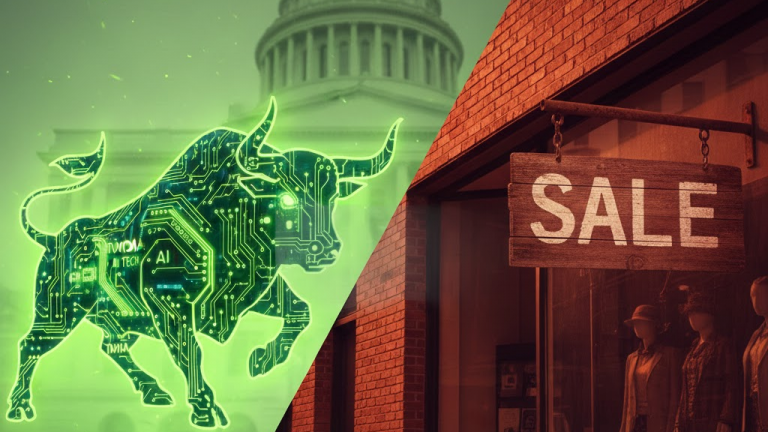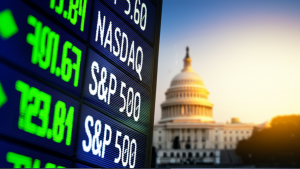Summary
The music stopped for the market’s high-flying AI rally this week. The S&P 500 and NASDAQ snapped a three-week winning streak, with the tech-heavy NASDAQ tumbling 3.0%, its worst week since April.
This wasn’t a broad-based panic. It was a severe and targeted re-rating of the technology sector, which had become priced for perfection. This “valuation speed bump” was sparked by a “sell the news” reaction in AI-darlings and was then dangerously amplified by a toxic macro-political backdrop: the U.S. government shutdown, which officially became the longest in history.
This shutdown created a “data vacuum,” forcing investors and the Federal Reserve to “fly blind” without an official October Jobs Report. Into this void stepped a string of catastrophic private-sector data points that signaled the “real economy” was breaking. The week’s climax came when Fed Governor Christopher Waller, reacting to this same bleak data, signaled a major dovish pivot, putting “sooner” rate cuts firmly back on the table.
This chain of events triggered a violent rotation. The tech rally, built on a “growth” narrative, crumbled. In its place, a new rally in beaten-down, rate-sensitive sectors like Real Estate began, as the market rapidly repriced for a new, darker economic reality.
The Catalyst: Flying Blind in a “Fog of War”
The week’s single most important factor was the historic government shutdown. By entering its 38th day on Friday, it created a “data blackout” that delayed critical reports on jobs, inflation, and trade.
This “fog of war” economy had two profound effects:
- It amplified private data, forcing the entire market to trade on a limited set of non-governmental reports.
- It fueled uncertainty, which was a primary driver for a catastrophic plunge in consumer confidence.
With no official map, the market was hyper-responsive to the few private signals it could find. And those signals were flashing bright red.
- The Labor Shock: Thursday’s Challenger Job-Cut report was the week’s first shock. It showed a surge to 153,000 announced layoffs in October, the highest total for that month in over two decades.
- The Inflation Shock: Wednesday’s ISM Services PMI report, while beating on the headline, contained a toxic detail: the “Prices” sub-index surged to 70, its highest level since October 2022, igniting inflation fears.
- The Consumer Shock: Friday’s preliminary University of Michigan Consumer Sentiment report was the knockout blow. The headline index plunged, but the details were terrifying: the “Current Conditions” component fell to a 73-year all-time low. This was directly attributed to the shutdown, with consumers citing fears over non-payment of wages and benefits.
The Climax: The “Waller Pivot”
The Federal Reserve, also “flying blind” in the data vacuum, was forced to react to this same private data. After Governor Lisa Cook struck a hawkish tone on Monday, the alarming Challenger report on Thursday seemed to force a change in tune.
In comments on Thursday, Fed Governor Christopher Waller, a key voice at the central bank, signaled a major dovish pivot. He stated he would support “more rate cuts, and sooner” if he saw “serious deterioration in the labor market.”
This was the pivotal macro event of the week. Waller’s comments confirmed the Fed was seeing the same severe economic strains as the market, and it put a December rate cut firmly back on the table, overriding Chairman Powell’s previous skepticism.
The Aftermath: A Violent Rotation
The week’s narrative, the “AI bubble” re-rating fueled by a confirmed economic slowdown—was written clearly in the market’s performance.
The Tech Rout
The NASDAQ Composite was the clear loser, falling 3.0%. The Technology sector was the worst in the S&P 500, plunging 4.11%. This was a valuation-driven selloff, as the AI rally’s long-duration growth narrative is acutely vulnerable to economic uncertainty.
The “Sell the News” Earnings
This risk-off mood was evident in the unforgiving reaction to earnings. The S&P 500 was priced for perfection (forward P/E of 22.7), and anything less was punished.
- The AI “Canary”: The selloff was sparked by Palantir (PLTR), which plunged 7.9% on Tuesday despite beating estimates and raising its full-year outlook. This “sell the news” reaction in an AI-darling was the pivotal moment that let investors question “lofty valuations.”
- The “Cockroaches”: The market confirmed its “sell” bias by punishing other mixed reports. Norwegian Cruise Line (NCLH) fell 15.3% on a revenue miss, and Zoetis (ZTS) fell 13.8% on a guidance cut.
The “Pivot” Rally
This was not an indiscriminate selloff. The market was actively rotating. While the Technology sector was the worst performer, the Real Estate sector, which is highly sensitive to interest rates, was one of the best, rising 1.26%.
This is the week’s most important signal. Investors were selling assets priced for growth (Tech) and buying assets priced for a Fed pivot (Real Estate).
The Week Ahead: Flying Blind in the “Data Logjam”
For the week of November 10-14, the single most important factor for traders is that the “data vacuum” continues. Due to the ongoing government shutdown, the market will not receive the official, high-stakes economic reports it was anticipating.
The market now faces a potential “data logjam.” The primary focus will be on the Consumer Price Index (CPI), scheduled for Thursday. If the shutdown continues, this critical inflation report, along with PPI and Retail Sales, will also be delayed, leaving the market to trade in the data void for another week.
If the data is released, it could cause massive, pent-up volatility as the market’s new dovish assumptions are tested against an official economic map. The earnings calendar also remains critical, with reports from Cisco (CSCO), The Walt Disney Co. (DIS), and Applied Materials (AMAT) set to provide crucial reads on enterprise spending, the consumer, and the AI-semiconductor cycle.
With no official economic map, the market will remain in a “fog of war,” hyper-focused on the few data points and earnings reports that are available.
Key Earnings Reports to Watch
With earnings season winding down, the focus shifts to bellwethers that can provide a read on the economy’s underlying health.
- Monday: Tyson Foods (TSN), Occidental Petroleum (OXY)
- Tuesday: Sony Group Corporation (SONY)
- Wednesday: Cisco Systems (CSCO)
- Thursday: The Walt Disney Co. (DIS), Applied Materials (AMAT)
- Friday: Alibaba Group Holding Limited (BABA)
Why it matters: The reports from Cisco and Applied Materials will be a crucial test for the battered tech and semiconductor sectors. After last week’s AI-led rout, their guidance on enterprise spending and the chip cycle will be critical. Disney’s report will offer a vital, ground-level look at the health of the global consumer, whose confidence just hit an all-time low.
Key Economic and Policy Events
With the official data on hold, the market will be trading on scraps and speeches.
- Fed Speakers: Several Fed officials, including New York Fed President John Williams, are scheduled to speak. In the data void, their interpretation of the economy and hints about the December rate cut will have an outsized market impact.
- Private Data: The market will again scrutinize any available private data, such as weekly jobless claims, for more clues on the labor market’s health.
- International Data: With U.S. data missing, international reports like China’s Industrial Production and Retail Sales (Friday) and UK/Eurozone GDP (Thursday/Friday) may have a larger-than-usual influence on global risk sentiment.
Disclaimer: This article is for informational purposes only and does not constitute financial, investment, or legal advice. The information provided is a synthesis of publicly available data and expert analysis and should not be considered a recommendation to buy or sell any security. Investing in the stock market involves risk, including the possible loss of principal. Past performance is not indicative of future results. Readers should consult with a qualified financial advisor to determine an investment strategy that is suitable for their own personal financial situation and risk tolerance.






















